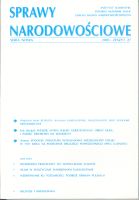Droga do identyfikacji narodowej. Stosunki narodowościowe na Rusi Zakarpackiej w przededniu I wojny światowej i w okresie międzywojennym
The Road To National Identity: Subcarpathian Rus On The Eve Of WWI and In The Interwar Period
Author(s): Michał JarneckiSubject(s): Cultural Essay, Political Essay, Societal Essay
Published by: Instytut Slawistyki Polskiej Akademii Nauk
Keywords: Subcarpathian Rus - national identity; autonomy;
Summary/Abstract: In the 19th and in first half of the 20th centuries the area that would come to be known as Subcarpathian Rus was one of the most backward regions of Europe. Although Ruthenians made up the majority of the population, Hungarians had dominated there for a very long time. The first signs of the Ruthenians' national awakening appeared in the mid-19th century (1848/49). Some showed a Russophile orientation based on the belief that Ruthenians formed a separate part of the Russian nation. Greek Catholic priests were prominent amongst Ruthenian activists. In the second half of the 19th century there was a phase of intensive “Magyarization” throughout the Hungarian lands. Local groups of intellectuals loyal to Budapest were called “Magyarons.” However, authorities also tolerated new local options: among them a Ukrainian orientation which suggested that Ruthenians were a separate nation (neither Russians nor Ukrainians). The Hungarian elite considered their main enemy to be the Russophiles. After WWI Subcarpathian Rus was incorporated into the Czechoslovak Republic. The new government feared Hungarian irredentism and harassed this ethnic group with administrative methods. This left no-Hungarian ethnic options open to Ruthenians. Prague was not consistent in this matter: it preferred the Ukrainian orientation, next the Russophiles, and finally the “Ruthenians” (“Rusnacs”). The rivalry between the Ukrainians and the Russophiles for the “rule of souls” was bitter. They particularly argued about the language to be used at schools. Religious conflict between the Orthodox and Greek Catholic was also common. The Czech authorities failed to introduce autonomy to the region in 1919. Therefore, the government was attacked both by the Russophile and Ukrainian separatists. In 1938, after the Munich Conference, the weakened Czechoslovak Republic granted Sub Carpathia autonomy. The local government soon became dominated by the Ukrainians. This process ended with the Hungarian occupation in March 1939. Despite the dilatory sometimes cynical and centralistic politics of Prague in 1919-1938, the process of national identification subsequently accelerated with the approval of the Third Reich.
Journal: Sprawy Narodowościowe
- Issue Year: 2005
- Issue No: 27
- Page Range: 101-116
- Page Count: 16
- Language: Polish

